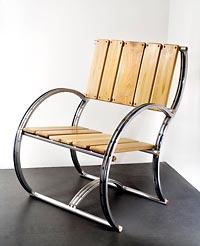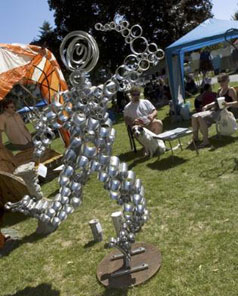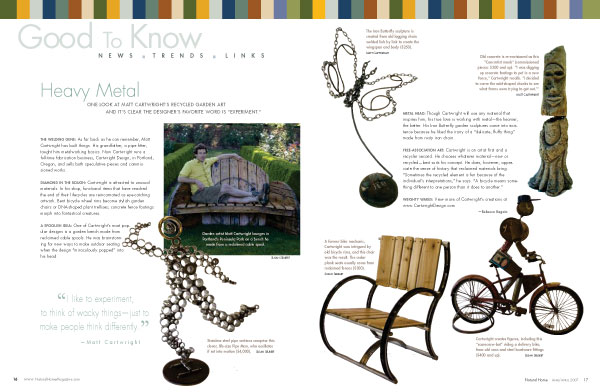Trying to get a handle on public art
By Matthew Kangas
Special to The Seattle Times
November 17, 2006
Public art has played an important role in the life of the arts in Seattle. A new exhibition at Gallery4Culture, "Arts Parts: Artist Made Building Parts Registry Artists," offers the public a look at how dedicated tax dollars are being spent to enhance and ameliorate our civic built environment.
To backtrack briefly, Seattle was among the first cities in the nation (after Honolulu and Philadelphia) to require 1 percent of all public capital construction budgets to be spent on art. From 1975 on, Seattle became the model of how to spend such money: either through purchases of art that could be moved from building to building ("portable works") or through the invention of the "artist-design team" wherein artists became equal partners with architects on important public building projects like hydroelectric power substations or sheltered workshops for the disabled.

King County soon passed similar legislation but, as the new show illustrates, the results were very different. Instead of allowing the artist to influence the architect and arrive at an exciting new hybrid building, the county set up in 1992 the artist-made building parts registry.
Curator Greg Bell (who is also the county's art collection manager) invited 23 artists from Washington and Oregon out of the 92 on the register to submit examples of their works for the exhibit. The 21 works on view give a frustrating glimpse of how the program operates. Each work is a sample rather than a fully evolved project.
Since the registry is available on a Web site (www.4culture.org/publicart/registry), "Arts Parts" is a unique curatorial exercise, too. While most gallery exhibits are posted online, "Arts Parts" is essentially a Web site that became an exhibition. It all makes sense if you consult the site (available at the gallery) to learn the full story. Without the online aid, the show's weak points Ñ fragmentary examples Ñ make the whole idea hard to appreciate.
That said, homeowners, architects and developers should visit the show in order to learn and gain more information by seeing the real objects. Each artist is available for private residential or commercial jobs as well as the civic ones the county promotes. A few artists have well-known projects with which viewers may be familiar. Cappy Thompson and Erin Shie Palmer have huge artworks at Seattle-Tacoma International Airport. Peter Reiquam made the steel armchairs on the side plaza at Meany Hall on the University of Washington campus. Phillip Baldwin made doors and gates for both the Snohomish Public Library and Bainbridge City Hall. Exhibit review
Leo Berk's "Low Ceiling" (2006) is a permanent piece in the gallery's conference room. Don't miss this beautiful lighting system.
More accessible and affordable are Matt Cartwright's cedar-seat chair made of aluminum bicycle rims and Ries Niemi's hammered stainless-steel door pulls.
Niemi is one of the few artists on the registry to have made the transition from the artist-design teams to the registry of building parts. Too many of the works, however, do not give a clear idea of the artist's ability or convince the viewer that the artist has the wherewithal to undertake a major project, let alone a stone pathway for Grandma's back garden.
Gallery 4Culture, the county's public art exhibition venue, has become a great forum for emerging and experimental artists, some of whom also do publicly financed artworks. It's never been easy to display the fruits of the many facets of art in public places. "Arts Parts" is another stab at this, but Bell hasn't really pulled it all together into a coherent, cohesive look at how public art has changed since the early days. That is an exhibit I am still waiting for.
Copyright © 2006 The Seattle Times Company
Sitting in style
By Neda Raouf
The Broomfield Enterprise
September 2, 2006
A lotus flower, boulders and musicians will become permanent displays in Broomfield over the next two months.
They are among 10 bench designs that will find homes in parks and open spaces -- all in what is the first official public art project for the city and county.
"There's a difference between a bench that someone decorates and a piece of art that someone can sit on," said Kate Mackey, chairwoman of the Public Art Committee. "We basically have functional art instead of benches that are artistic."

The first bench -- Lotus by Portland, Ore., artist Matt Cartwright -- was installed at Tom Frost Reservoir in open space at the corner of Lowell and Midway boulevards on Wednesday and Thursday, a week ahead of schedule. The 7-by-13 foot bench by Cartwright, whose parents Jim and Lucy live in Broomfield, is made of stainless steel pipes and flat bars, designed to resemble five petals fanning over and around a red lotus table made of colored acryllic and glass.
Benches by six artists were picked from 37 proposals.
The Public Art Committee received the proposals, which were approved in May by City Council after a public comment period.
The benches -- made from a variety of materials -- have a price tag of $108,067, and there is an additional cost of $4,000 to $5,000 for customized concrete pads, said Cultural Affairs Manager Alisa Zimmerman.
Not all of the benches will need pads -- those installed in open spaces will be stablized with pins, she said.
"The weight of some of these benches is a couple of tons," Zimmerman said. "So they would sink into the ground for lack of these pads."
The committee accepted proposals for the project in April.
Community comments on the designs were taken May 18-20. Those comments were presented at a May 23 council meeting.
Initially 11 artists were to create benches, but one could not fufill her contract and the city decided not to install a bench at Interlocken East Park.
That artist was not paid, Zimmerman said.
The Open Space and Trails department and its advisory commitee were involved in plans for benches in natural areas, she said.
"(We) tried to be particularly sensitive to those designs," she said.
Public comments overall were positive, with some "thrilled" by certain selections. A few comments expressed concern.
One comment criticized the lotus flower pattern and another disagreed with the metal material for the Mustard Seed bench.
Another seemed uncertain about the designs overall.
"I don't like any of them! But I guess I don't know art when I see it," one comment read.
Mackey said no major faction emerged for or against the project.
"One of the important aspects of public art is to create conversation," she said. "We are a very conservative committee and this is a very conservative town, and it's not like we were picking some very controversial pieces. But there is going to be a matter of taste."
The committee thought a project with benches would be the most resident-friendly, she said.
"What unifies the project is functionality," she said.
The goal also was to have pieces that would touch more people in more places on display in public areas.
"We chose sites that were very visible we hoped and very accessible," she said.
The benches will be installed through the end of October.
Artists turn castoffs into cash
By Jeffrey Mize
The Vancouver Columbian
August 6, 2006
Matt Cartwright came up with the inspiration for Pipeman while doodling as he was talking on the phone.
He noticed his series of connected circles vaguely resembled the shape of a human. Cartwright, having once worked for a Hillsboro, Ore., company that built machinery for food processors, had just the materials to turn his idle inspiration into artistic reality.
"When they went out of business, I was bequeathed a 50-gallon drum of pipe cutoffs," he said during Saturday's Recycled Arts Festival at Esther Short Park.

The result was a gleaming 300-pound assembly, welded together from more than a hundred spare pipe sections, that needs a new home. Cartwright, of Cartwright Design in Portland, thinks a prominent spot outside a business park or a more laid-back location in someone's backyard would be ideal.
All it takes is someone willing to pay the $5,000 price.
"That's kind of an asking price," Cartwright said. "I can bargain on that."
The Recycled Arts Festival, sponsored by the Clark County Solid Waste Program and the Environmental Information Cooperative, brought together about 50 vendors who have transformed castaway items into arts and crafts.
While Cartwright's Pipeman was shiny, Steve Dietel's scarecrow was rustic. Dietel, of Howling Heights Metal Designs in Venersborg, pieced together his scarecrow from saws, ax blades, hand drills and other items most covered with a dull coating of rust.
The asking price: $299. Delivery will cost you another $35.
Nate Jensen took a long look at the scarecrow before walking away.
"A little out of my price range," the Vancouver resident said. "If I had the money, I would. It would be cool to have in my backyard."
Saturday's event featured an assortment of creations: faux stained-glass art with real window frames, aprons sewn from fabric samples and bowls made from vinyl records, relics from the era when CD stood for "certificate of deposit," not compact disc.
Catherine McClusky of Good Karma in Vancouver was assembling handbags that prominently displayed art from album sleeves. Customers could bring their own albums or select one from the small stack she had available Saturday, including Elton John's 1975 classic "Captain Fantastic and the Brown Dirt Cowboy."
"I've sold two purses with that; people love that album," said McClusky, whose company's motto is "Recycled Designs for Modern Times."
Good time on the cheap
Larry Peacock of Home & Garden Metal Sculpture in Aloha, Ore., was selling a variety of handcrafted items, including bird feeders, salt and pepper shakers and a chess set fashioned from old CO2 cartridges.
"I haven't sold anything, but I've had a good time," he said.
His lack of sales was offset by not paying any rental fee for booth space and by shelling out only $1.50 to park in the Vancouvercenter's garage. Some tasty food from the Vancouver Farmers Market next door was an extra benefit, Peacock said.
Scattered along the park's walkways were small placards promoting the virtues of recycling. For example, how many people know that recycling a single aluminum can saves enough energy to power a television or computer for three hours? Or that recycling a foot-high stack of newspapers conserves enough electricity to heat a home for 17 hours?
The Recycled Arts Festival continues today from 10 a.m. and 4 p.m. at Esther Short Park. Mudeye Puppet Company will perform at 11:45 a.m. and help families make their own puppets afterward.
Like the outdoor farmers market next door, the festival is free and pet-friendly.

